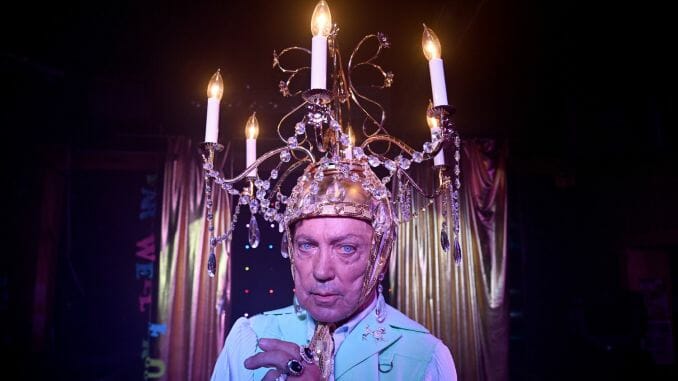Udo Kier Has Always Been Ready for His Close-Up, Mr. DeMille. In Swan Song, He Gets It

Claiming German actor Udo Kier is a legend is probably one of the bigger understatements you’d make in your life. His career spans genres, small-time and big-time directors, and, frankly, space and time itself. He has appeared in a delightful plethora of iconic films including Dario Argento’s Suspiria, Gus Van Sant’s My Own Private Idaho and Lars von Trier’s Melancholia—and that’s just naming a few. In my mind, he’s the equivalent of a high-flying trapeze artist at the best (and most humane) circus in the universe: He’s here, he’s there, he’s everywhere and he makes it look like the easiest thing in the world.
When Mr. Kier’s bright and shiny voice greets me on the other end of the phone, his excitement and sheer pride for his new film, Swan Song, is infectious and, of course, he’s (rightfully) pleased with his own performance. The movie follows Pat Pitsenbarger, an aging queen with a vibrant reputation as Sandusky, Ohio’s best hairdresser, who breaks out of the confines of his nursing home facility to journey crosstown to do hair and makeup for a rich former client’s funeral. Finally, he alone is standing center stage—and being handsomely rewarded for taking on the actor’s age-old task of tapping into their vulnerability for all to see.
“I couldn’t believe that, in 50 years working as an actor, I got the best reviews of my life,” he says of the glowing comments about the film, written and directed by Todd Stephens. Yes, Todd Stephens of Another Gay Movie, a film in which I personally find a lot of slapstick joy. The two pictures are wildly different in tone and comedic style, but there is something homegrown and passionate about Stephens aging into creating quiet, yet sweeping dramedies like Swan Song and taking a larger-than-life figure like Kier along for the ride.
It’s clear Kier is grateful to Stephens for the privilege of a leading role like Pat. Even his incredible past as an actor can’t overshadow the thrill of top billing.
“[Movies like] Suspiria, Blade, I never had the leading part. That’s the difference. Ok, in 1973, I was Dracula and Frankenstein, but in 1973,” Kier emphasizes, like those films weren’t directed by Andy Warhol’s longtime pal and Factory collaborator Paul Morrissey. Like they won’t live in an interesting type of arthouse infamy. “Long time ago,” he says.
It was even different when working with Willem Dafoe and John Malkovich on 2000’s Shadow of a Vampire. “I was just one of them. Ensemble work,” he says with a flair of French lilt. “But in Swan Song, it’s Pat. It’s a character from the beginning. It starts with the character and ends with the character. People can follow the character from the beginning to the last shot, and I think that’s the difference.”
Despite his lack of leading material over the years, Kier knows his career is one for the books, and that he doesn’t need to pander to find compelling roles. “I’m a lucky man,” he says with a laugh. “I have never [told] a famous director, ‘I would like to work with you.’ Imagine if I said to David Lynch, ‘I would like to work with you.’ He would say, ‘Who doesn’t?’”
That said, he isn’t afraid to gush over some of his wishlist of future collaborators, or even reveal his most charming tactic when meeting an artist he admires. “I would love to [work with] Terrence Malick. I love Terrence Malick. I love David Lynch. But I never [tell] a director, ‘I would like to work with you.’ I only say the truth: ‘I like your movies,’” he says, sincerity dripping from the phrase. “If they want me, you know, they know how to find me.”
It seems directors aren’t the only ones who know where to discover Kier and his impeccable work. He’s finding a fanbase of young filmheads, which, frankly, leaves me feeling optimistic about the future before us.
“Yesterday, we had a Q&A [in Los Angeles] and there were really young people and some of them said, ‘This is one of my favorite films.’ 20 years old and that age range,” the actor gushes before specifically noting how refreshing it is to see young people bringing the theater experience back in a big way amid COVID-19. “People want to go to the cinema again and see stories like this where they get tears in their eyes and they’re also laughing.”
Kier feels it too; it isn’t just me who sees something vivid and beaming about those in the seats at his Q&A, those growing up in today’s film landscape who see movies like these as quiet gifts. Kier also sees the connection between those twentysomethings in the theater watching Swan Song and the older generation—those who, like Pat, are from an era when things were different.
-

-

-

-

-

-

-

-

-

-

-

-

-

-

-

-

-

-

-

-

-

-

-

-

-

-

-

-

-

-

-

-

-

-

-

-

-

-

-

-








































